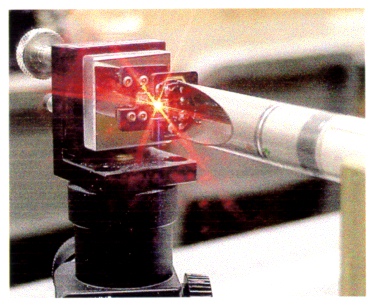
PHYS 431 - OPTICS LAB, FALL 2004
Lab coordinator:
Office Hour: Thursdays at 2 pm, Rm 1250 BPS
Teaching Assistant: Joo Han Park
Room 4237 BPS Building
Telephone:355-9200 x2210
Email: tessmer@pa.msu.edu
Lab Technician: Mark Olson

Lab coordinator:
Office Hour: Thursdays at 2 pm, Rm 1250 BPS
Teaching Assistant: Joo Han Park
Room 4237 BPS Building
Telephone:355-9200 x2210
Email: tessmer@pa.msu.edu
Lab Technician: Mark Olson
Below is a summarize the content and requirements of the lab.
Requirements
You are required to attend one 2.8 hour lab per week. We require you to use a
lab notebook to assist you in organizing your experimental notes and for
recording raw data. This notebook will not be turned in with your write-ups,
but may be checked for a variety of reasons. Please also bring a 3.5” floppy (or a pocket USB flash memory drive)
to allow you to bring home digital images. There will be no opportunities to
make up missed labs. Please consult Prof. Tessmer for cases where more than one lab
is missed for legitimate reasons (such as an extended illness).
Partners
The experiments will be performed in groups of two. Groups of three should
only occur if more than eight students are present or if an odd number of
students attend. Of course, you should divide the labor with your partner.
For example, only one person need record the data in their lab book. Although
each group must perform the experiment
independently, you are encouraged to observe and discuss experimental points
with the other groups.
Write-ups
Click here for write-up example.
Each partner is required to write a formal report for each experiment performed,
usually due at the beginning of the following lab (see lab table below). We will have 11 experiments in all.
Each group must perform their own analysis, and the write-ups must be written
independently. Hand written reports will not be accepted. The write-ups should
be prepared using a word processor, such as MS Word, with imported graphics and
images when applicable. The format is based on the style of a Physical Review
article. Each report is worth a total of 10 points. The following sections must
be included (point values shown in brackets).
Title [0]
Abstract [1]
Introduction [2]
Analysis & Discussion [5]
Conclusion [2]
Labs
Here is a tentative list of the labs. Click below to see the complete procedures. You are strongly
encouraged to read them in advance of each lab.
Grades
Your score will consist of the highest 10 of the 11 write-up scores.
Hence the maximum point total is 10 x 10 = 100. At the end of the semester
your point total will be scaled to count 40% toward your final grade.
Absence / Late Policy
There will be no opportunities to make up a missed lab. If only one lab
is missed, there is no need to provide an excuse, as only the highest 10
of 11 labs count toward the final grade. If more than one lab is missed
with a legitimate excuse such as an extended illness, you should inform
me by email (tessmer@pa.msu.edu) or phone (355-9200x2210) within 48 hrs
following the lab. In most cases I will ask for some documentation, such
as a doctor’s note.
Students who arrive late may not be allowed to do the lab, at the
instructor's discretion. Labs that are turned in after their due date
will be penalized by one point per day. For example, a lab turned in a
week late will be penalized by seven points. If the lab was turned in
late for a legitimate reason, once again you should notify me within 48
hours. In most cases I will ask for some documentation, such as a doctor’s
note.
Sec 001 -- Mon 6pm
Sec 002 -- Wed 6pm
Sec 003 -- Tues 6pm
Sec 004 -- Wed 3pm
Title of experiment. Please include your name and the name of your partner at the top of the title page.
This briefly states the major result of the experiment. For example:
“A Michaelson interferometer has been used to determine the difference in
wavelength of the sodium D lines. A value of 5.9 ? 0.2 Å was found, which
agrees with the accepted value.”
This summarized the main ideas of the experiment and the conclusions of
appropriate theory. A sketch of the experiment should be included.
Quantitatively compare your data with expectations. Error estimates must always
be given. Do not recopy all the raw data for your report. Give examples and/or
the range of the numerical values where appropriate. Present data by graphs as
much as possible. Do the measurements ? error estimation agree with theory? If not,
can you suggest possible sources of the discrepancy?
A brief statement summarizing your results is required. Did you find what you
expected? What improvements would you make if you were to repeat the measurements?
WEEK
LAB
DUE DATE
Sept 20-22
L1: Thin Converging Lens
Sept 27-29
Sept 27-29
L2: Thin Divergent Lens
Oct 11-13
Oct 4-6
L3: Periscope and Telescope
Oct 11-13
Oct 11-13
L4: Microscope
Oct 18-20
Oct 18-20
L5: Interference Fringes & Newton’s Rings
Oct 25-27
Oct 25-27
L6: Michelson Interferometer
Nov 1-3
Nov 1-3
L7: Single & Double Slit
Nov 8-10
Nov 8-10
L8: Diffraction Grating
Nov 29-Dec 1
Nov 15-17
L9: Spatial Filter
Nov 29-Dec 1
Nov 29-Dec 1
L10: Polarization
Dec 6-8
Dec 6-8
L11: Atomic Force Microscope
Dec 16